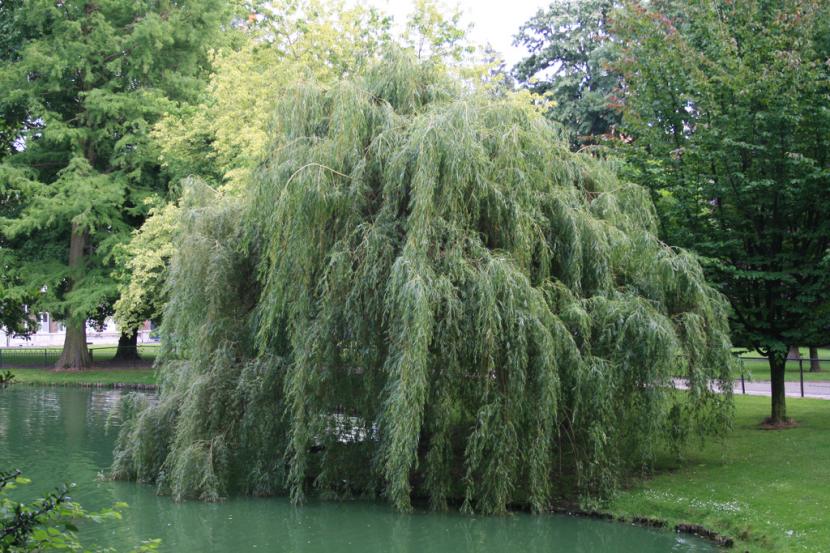
In Asia we find very unique and beautiful plants, such as the popular Japanese maples or our protagonist: the Weeping willow. This is a tree that lives mostly in eastern China, very close to swamps or wetlands.
It is a perfect plant to have in large gardens, where it can be viewed as an isolated specimen and thus be able to enjoy the pleasant and beautiful shade it provides during the warmer months. In this special we are going to pay tribute to one of the most famous tree species. Not only will you know what care it requires, but we will also tell you what medicinal properties does it have. Are you going to miss it?
Weeping Willow Characteristics
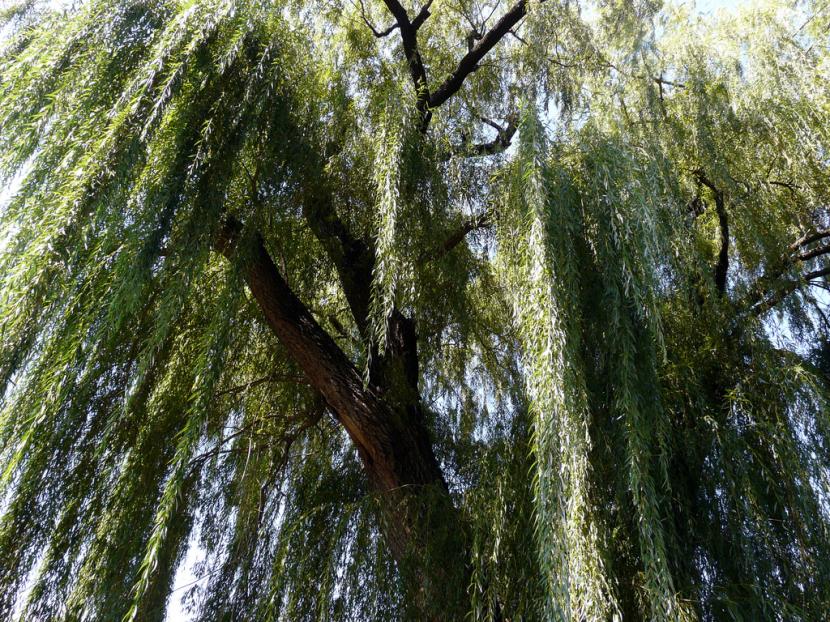
This incredible work of nature is scientifically known by the name of salix babylonica. Belonging to the Salicaceae family, it is a tree that in principle is considered to be deciduous (that is, they fall in autumn), but the reality is that there are specimens that keep them practically all year round and there are others that do not drop them all. Depending on the climate (the milder it is, the longer it will remain perennial) and on the genetics of each tree it will have one behavior or another. Its average height is about 15 meters, reaching 20 if growing conditions are favorable; and from its branches, which fall like a waterfall caressing the ground, sprout lamceolate leaves of about 15cm in length, glaucous on the underside and green on the upper side.
The flowers, which are distributed in inflorescences, are unisexual, that is, those of each sexual gender have their own characteristics: those of the male feet have 2 free stamens, while those of the females have 2 stigmas. Towards the end of winter sprout together with the leaves, welcoming the most colorful and joyful season of the year with one of the first natural spectacles that you can enjoy in your garden during the season.
The bark of its trunk is dark brown in color which, while the youngest specimens have it more or less smooth, as they get older it presents fissures typical of aging. By the way, although it does not have a very long life expectancy, it can live several decades, specifically a few 60 years. However, if you have children or you from time to time like to go back to your childhood, you should know that the weeping willow anchors very well to the ground, so ... Climb without fear! 😉
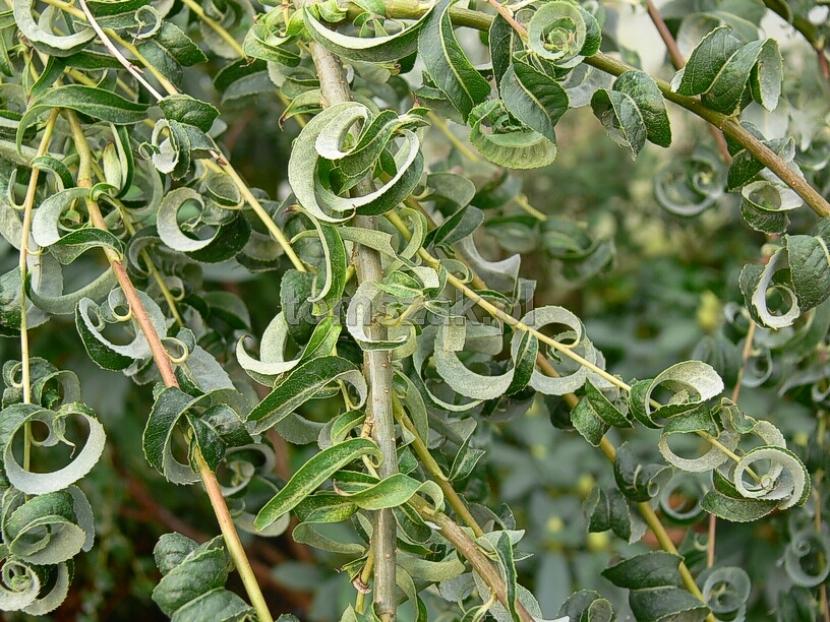
Salix babylonica 'Crispa'. Image - TOMSZAK
It is often hybridized with other species of its genus, giving rise to very interesting specimens such as the Salix x sepulcralis which has the branches of a more yellowish color. In addition, there are multiple cultivars, among which we highlight the 'aura'because of the yellow color their leaves acquire in autumn, and the'Crispa'whose curly leaves give it a spectacular appearance.
The Weeping Willow is very rustic, withstanding the frosts of up to -10ºC. But like all plants, he also has his preferences. And it is that we are facing a moisture-loving tree that will vegetate wonderfully if it is planted near ponds, rivers or swamps. In addition, due to the adult size that it reaches, it is highly recommended to plant it as an isolated specimen; although you can also choose -but it is not frequent- to plant them in rows, leaving a minimum distance of 10m between them to create shady areas.
How to reproduce the Weeping Willow
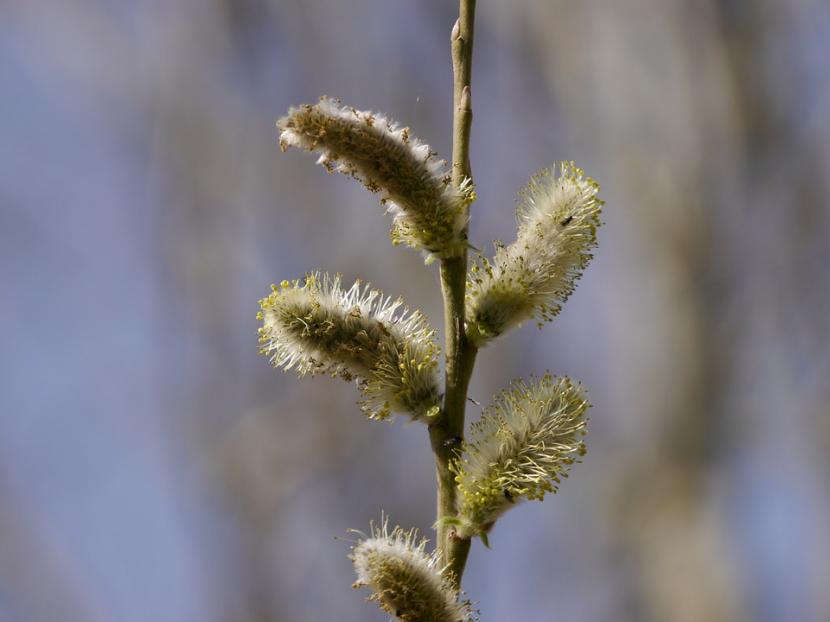
In addition to the qualities mentioned and others that I will tell you later, we cannot stop telling you the following: easily reproduces by cutting, on the 'female feet'. Its seeds can also be sown, but this method of reproduction is hardly used. Let's see how to proceed in each case:
Cutting
It is one of the few trees that reproduce so easily. As it is a deciduous plant, cuttings are usually obtained in autumn and winter, when it no longer has leaves. For it, Several healthy 1-year-old branches are chosen that are the thickness of a pencil, and from these, pieces of about 30cm in length are made.
Now, I recommend that you remove a bit of bark from the base with a cuttex, leaving about 3cm without it. Then it will only be left to moisten the base and impregnating it with rooting hormones in order to root as soon as possible.
Finally, plant them in pots with porous substrate (It can be 100% perlite, or if you prefer, mix it with black peat in equal parts), give them a good watering and place them in a corner where they are not directly exposed to sunlight, outside.
Seed
Weeping willow seeds are very difficult to obtain, let alone viable seeds. They are quite reminiscent of the dandelion plant (Taxodium officinale), as they are feathery and quickly blown away by the wind. To this must be added that its viability period is very short, so it is convenient to take them immediately from the tree.
Once at home, the cottony 'fibers' will be removed and placed in a glass of water for 24 hours to begin to wake up. The next day they will be sown, for example, in a seedbed tray - like the ones we normally use to sow seeds of garden plants - with a substrate composed of black peat and a little perlite at an approximate ratio of 7: 3. The ideal location will be one where it receives as much sunlight as possible. As for watering, as we are talking about a moisture-loving plant, they have to be frequent.
Still, I would like to emphasize that the seeds often do not germinate, despite being 'pampered' a lot. That said, weeping willow is a very inexpensive plant that you can find in any nursery. Don't worry 🙂.
What care does it require
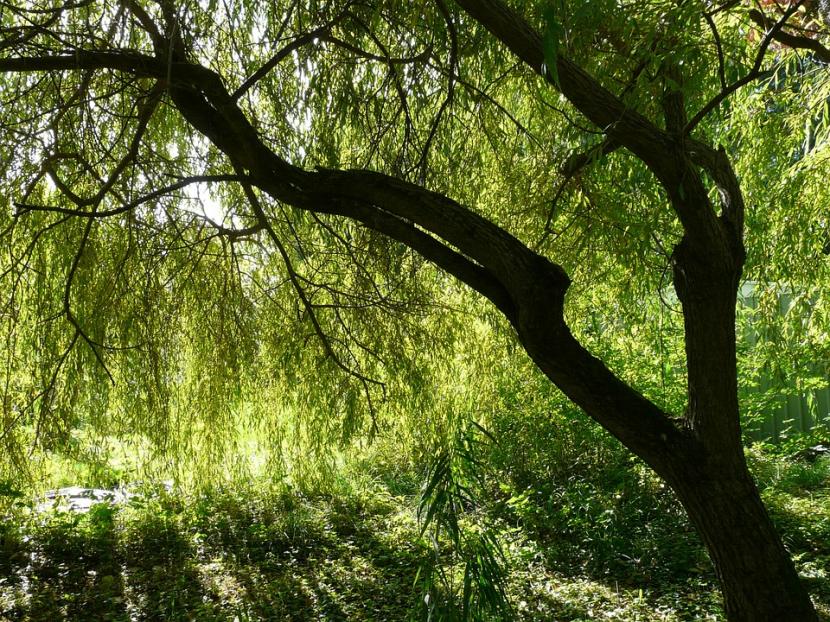
It is a very grateful tree that will give us many and great satisfactions. It is very rustic and resistant, and also very adaptable. It grows in all types of soils and will live without problems in a wide variety of climates (except those that are extremely cold), in a place where it can be exposed to the sun. Because it needs high humidity both in the soil and in the environment so that it can develop normally, It must be planted near waterways so that we can contemplate it in all its splendor.
But it has a small drawback and it is that its roots are very invasive. Therefore, it must be located at a minimum distance of 10 meters from pipes, cemented floors or any type of work; otherwise it could destroy her… literally. It is a very beautiful species that needs to be able to have enough space so that it can grow without creating problems; otherwise it will end up having a fate that many have already suffered: poisoning and subsequent logging.
To avoid reaching that situation it is very important to know the adult dimensions of the plantsWhether from the weeping willow or any other, and also know what behavior has its roots.
If we talk about pests and diseases, it is often affected by: aphids, mealybugs, Caterpillars, roya y powdery mildew. It is highly recommended to do preventive treatments in spring with insecticides whose active ingredient is Chlorpyrifos or Dimethoate, and with natural fungicides such as copper or sulfur.
Still, if you are very excited to have one, you can always choose to work it as bonsai.
Caring for Weeping Willow as Bonsai

Image – JP from HIRYUEN
We are not going to fool you: normally trees with long leaves are not used as Bonsai, since in addition to transplanting, pruning and fertilizing, it is also important to try to reduce the size of their leaf blades. And this is something that takes time. Still, due to its high ornamental value It's worth a try. In fact, real wonders have been achieved.
The first thing to do is observe the 'movement' of the trunk to decide what style we want to give it; although this will not be difficult since they have their own: crybaby 🙂. If it is a very young plant, whose trunk thickness does not exceed 2cm, I advise you to plant it in a colander with akadama and water it often. Thus, in a matter of a maximum of 2 years you will be able to start working on it.
Pruning
Once the time has come, We will take advantage of the winter to remove all the remaining branches and the summer to make pinches. With these we will also cause a reduction in the size of the leaves.
Transplant
The transplant will take place at the end of winter. You can take advantage and transplant it the same day you prune it. Use akadama alone or mixed with 10% black peat.
Wiring
To give it the typical shape of these trees, Its branches will be wired in spring and they will be removed after 2-3 months to prevent them from leaving marks.
Subscriber
Throughout the growing season, that is, from spring to late summer (reaching into fall in mild climates) It must be paid with a complete specific fertilizer for bonsai every 20 days.
Can it be grown in a pot?
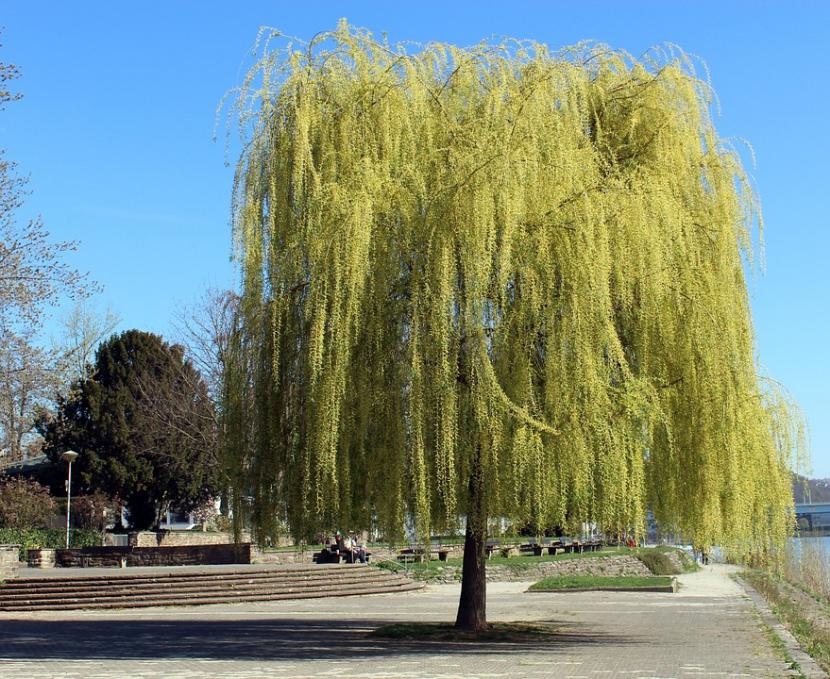
The Weeping Willow is a tree that, due to its size and the behavior of its root system, not suitable for pot. Now, if we take into account that it can be worked as bonsai, it can be interesting to do something similar. But, yes, you should know that you will have to keep it at bay by pruning and that it will probably never look as pretty as the ones that are planted in the ground. To this must be added that willows have a tendency to rot inside over the years. But, as we said, being a species that reproduces easily by cuttings you can try to have it in a pot.
To do this, the first thing to do is look to locate the pivot root, which is the thickest and longest of all that helps it to hold itself well to the ground, but as it develops it may end up removing the pot tree. So, at the end of winter and whenever possible (that is, as long as the substrate attached to the roots is not extremely 'hard'), it will be removed from the pot and, with great care, the substrate will be removed. Once the roots are visible, we will locate the pivot and we will prune it. Afterwards, we will apply healing paste to the cut to prevent fungi from affecting it.
Then, it will only be a matter of planting it in a large plastic pot with black peat mixed with 20% perlite. It is advisable to water for 3-4 months with water that has been added a few drops of Benerva -for sale in pharmacies- so that it heals better and faster.
But if you can't or don't dare to do this step, don't worry. You can move on to the next one: pruning branches. We will remove those that look weak and sick, and the others will be trimmed. The height can be lowered by reducing the length of the 'guide branch', which is longer than the others and is more in the center.
As for the compost, it is preferable not to pay otherwise the tree would have a faster growth and development.
Weeping Willow uses
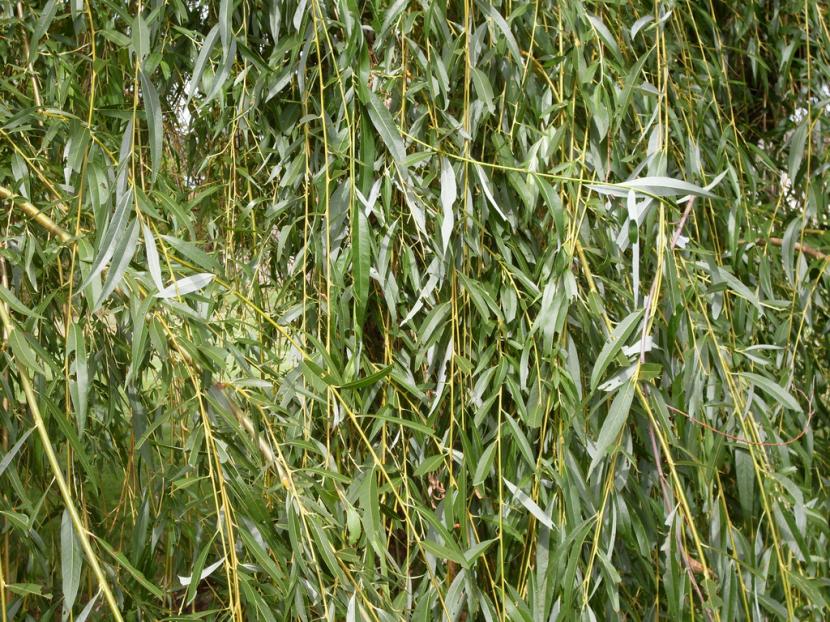
Now that we have seen its characteristics and the care it requires so that it is always splendid, let's see what uses is it given to this magnificent tree.
In gardening
The Weeping Willow is a very ornamental tree that is beautiful all year round. During the summer we can protect ourselves from the sun under its shade, and in winter its peculiar wavy branches are exposed. In addition, it is perfect for large gardens, where they can be used as an isolated specimen or in groups, thus creating a corner of incredible shade for the warmest season of the year.
And another very curious use that will come in handy when we make cuttings is that also serves as a rooting agent. This video explains how to do it step by step.
In natural medicine
The medicinal properties of this species are many and varied:
Internal use
Take 3 cups a day of infusion of young leaves (20 grams) and you will be able to take advantage of its many advantages:
- Relieve pain, whether head, rheumatic, muscular, ears ...
- Lowers fever, especially if it is flu or catarrhal episodes.
- Has anticoagulant properties, so the risk of suffering from cardiovascular disease is reduced.
- They help to be calmer, and also to sleep better.
- It is astringent, so you can use it to fight stomach upset.
External use
The bark boiled for 15 minutes in 1l of water heals wounds and burns. What's more, the resulting liquid fights inflammation of the mouth and treats throat infections like pharyngitis.
What you should keep in mind
Although it has important medicinal properties, you should know that if you have an allergy to acetylsalicylic acid (the active component of aspirin) you should not take it. In addition, you have to start with low doses to know how our body reacts; and only if there is no problem, we will continue with the Willow treatment.
Other uses
The wood of this tree, although light and not very resistant to inclement weather, It is used to make drawers, rustic furniture and also to obtain paper pulp.
Curiosities of the Weeping Willow

This is a tree that is much loved and appreciated by many, and it is no wonder since it has multiple uses. But if this seems little to you, there are a number of things that you are going to discover about this species that will probably surprise you.
And we will of course start by knowing what the meaning of its scientific name is: Salix babylonica:
- Salix: refers to the botanical genus to which it belongs.
- Babylonian: means 'native of Babylon'. Although we now know that it is originally from Asia and especially China, it was formerly believed that its place of origin was the territory that we know today as the Middle East.
Another curiosity is that a biblical meaning has been attributed to itas it is believed that Jesus Christ spent his last night praying under one of these trees. Perhaps for this reason there are those who think that it represents bitterness and despair.
Fortunately, times have changed and today it has a much more positive meaning. So much so that if you want to give someone something very special that represents your friendship, you just have to give him a weeping willow.
Botton line
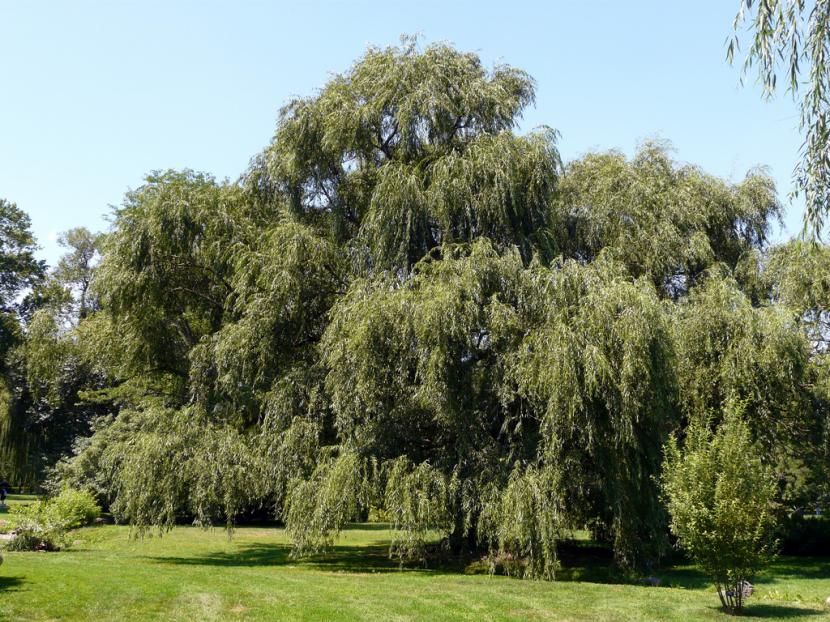
To finish, we leave you with a brief summary of a tree that is very interesting:
The Weeping Willow, or salix babylonica, is a very fast growing arboreal plant very resistant to cold temperatures. However, to be able to enjoy it and contemplate it in all its splendor it must be planted in a large garden, away from any construction.
Its cultivation and maintenance is very simple, suitable for those who have just entered the fascinating world of gardening and who do not yet have experience in plant care. You just have to plant it in a place where it receives a lot of light throughout the day, and if possible near some water source like a pond or some watercourse.
It reproduces easily by cuttings obtained in winter, emitting roots after only 2-3 months. What's more it has multiple medicinal properties.
What more could you want? 🙂
Good!
I have a willow tree that comes out like lumps in the wood and that is drying and falling… I don't know if it will be some kind of plague or disease… I don't know if it has ever happened to you? Ask at various Jardineria stores and they tell me it doesn't matter… I have photos… I don't know if you can help me know if I have to do something or not.
Thanks?
Hi Fany.
Can you upload the image to tinypic and copy the link here? In principle, if they dry out and do not affect the tree, it is not serious.
A greeting.
Hello. I would like to know how far from the house do you recommend planting an electric willow tree?
Hi Geraldine.
Willows have invasive roots. The minimum distance should be about 5-6 meters, but the further the better.
A greeting.
Hello. I have a Salix Alba with around 25 years old. For at least three years I have observed that the inside of the trunk is "emptying". Do you have any idea what it could be and how it could be treated?
Hello Maria.
Has this tree been pruned regularly? I ask because Salix that are pruned a lot become vulnerable to both fungi and insects (borers) that burrow galleries in their trunks and branches.
Anyway, even if you haven't pruned it, I recommend treating it with insecticides that contain Fention, Fenitrotion or Alphacypermethrin. This will remove any larvae you may have.
Greetings.
Hello: on the sidewalk of my son's house they have a weeping willow tree. They put it with the intention of providing shade to the house. But the truth is that I don't think it was the right choice. It does not give a compact shade that protects from the sun, especially in the summer. The ground is covered most of the year with dry leaves that give a very untidy appearance and is a strenuous sweeping job that is never finished. Its branches have become entangled in the cables and its roots have broken the sidewalk. It doesn't look like a pretty tree to me either. It has never been pruned and perhaps that has contributed to so many inconveniences. It seems to them…?….
greetings
Hello Magdalena.
Thanks for your comment.
Without a doubt, any poorly chosen plant in a bad place loses its charm.
The weeping willow is a tree for large gardens or parks, not for the streets.
Regards!
In this case, the tree is not guilty of anything, the one who planted it there had no idea of its care or information, surely they do not water it with enough water or daily. In my opinion it is a beautiful tree and I intend to make a garden in my apartment, although it is small, I will try to make a Bonsai Willow. Greetings take good care of the trees or finally ask to transplant it to the governor's office or the fire department.